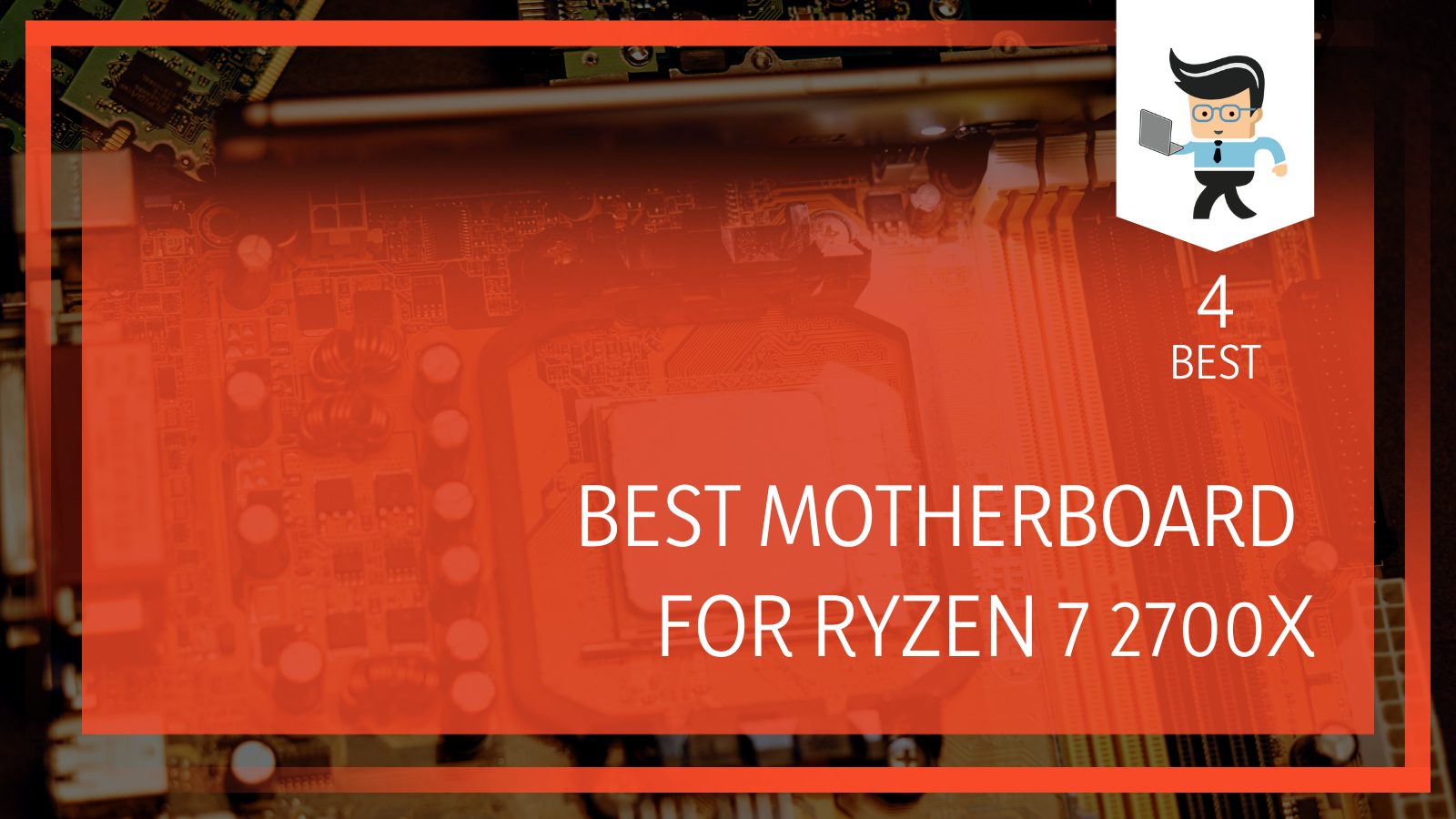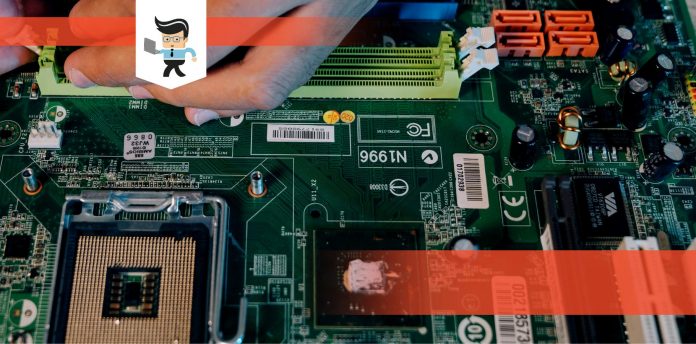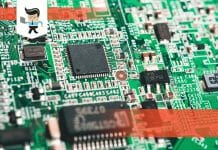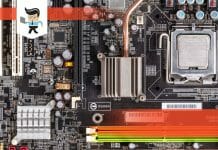The best Motherboard For Ryzen 7 2700x will do a lot of different things. The motherboard itself is built to work like a circuit board and keep your computer running at its best. It is actually the backbone of the computer that will connect and direct all of the different components and devices. As such, it is important to get the best possible motherboard so that everything works properly. You can add or take away elements or you can keep it as is.

Remember that the motherboard is the powerhouse of the computer because it gives directions and allows communication across other essential parts like the CPU, RAM, and more. Even if you know a lot about computers, there can be way too many options for the gaming motherboards for Ryzen 7 2700x.
Contents
Comparison Table
| Product | Pros | Cons |
| ASUS ROG Strix X470-F Gaming AMD Ryzen 2 AM4 DDR4 DP HDMI M.2 ATX Motherboard |
|
|
| ASUS Prime X470-Pro AMD Ryzen 2 |
|
|
| MSI Performance Gaming AMD X470 Ryzen 2 |
|
|
| ASROCK AMD X470 Chip Set ATX Motherboard X470 Taichi |
|
|
Selecting The Best Motherboard for Ryzen 7 2700X
When breaking down the best motherboard for Ryzen 7 2700x, there were so many different factors to take into consideration. These are the factors that will take your personal computer into overdrive and give them 5-way optimization. Each board we considered needs to balance two things perfect: performance and value.
We know that there are some extremely cheap boards out there that do some good things, but they don’t necessarily perform in other ways.
There are others that are extremely expensive and do a lot of great things, but they may not necessarily need to do them. We looked for a good motherboard for Ryzen 7 2700x that was worth the money but wasn’t too expensive and one that performed.
There are some common issues that we were able to check for, features that are essential, and some extras that make all the difference.
Some of the things we looked at included:
- The Form Factor: We first looked to see the size of the motherboard and the number of expansion slots. This helps to determine how versatile the motherboard will be. Sizing is important because if you do not get the size correct, it will not work. To select the right size for you, you should measure your old motherboard.
- The Processor Socket: Once you have determined the size of the motherboard, you need to look to the processor socket. You will need to determine which type you have – an LGA, PGA, or BGA. PGA sockets tend to be the most common option because you can actually upgrade these and add a different processor socket to your motherboard. You will need to weigh what your PC needs and what will work with the motherboard.
- Random Access Memory (RAM): The motherboard also determines the amount and type of memory that you will have on your PC. You want to keep this in mind when you purchase a motherboard because you will be limited if you don’t make a smart purchase. In general, 16 GM is the bare minimum for RAM that you should have. You may also want to look at the memory slots – you should look for a motherboard that has at least 4, but preferably more memory slots. This will give you some adaptability and features to utilize later on in its lifecycle.
- PCI Slots: PCI slots are among the most commonly used expansion types and most people who care to upgrade their motherboards will also need PCI slots. It may depend on how you are going to use your computer, but gamers will need at least one open slot. If you game frequently and have a few PCI cards that you need to use on a regular basis, you will probably want to have more than one. Remember that PCI slots can be different sizes, so make sure to read the fine print.
- Wi-Fi: If you are going to buy a motherboard, you want to have one with built-in Wi-Fi functionality. This isn’t standard in all motherboards, but it is a feature that absolutely should be.
- Other Features: If you are stuck between a few different motherboard options, simply look at the features. Be realistic about what you will use your computer for and what you will need. There are certain motherboards for Ryzen 7 2700x with built-in features that you can also buy on your own – but would it save you money to buy them already built in? For example, this can include audio features, Bluetooth, and other gaming features.
Once again, it can be almost impossible to find all of these features in one motherboard – but we were able to do some research and find some great options for you.
Best Motherboard For Amd Ryzen 7 2700x: Our Options
To determine the best motherboard for Amd Ryzen 7 2700x, we looked at many different options – and there are certainly plenty of them out there. Some motherboards come with a lot of hype and they fall short. Others are sneaky and while they didn’t seem too promising at first, they impressed us. But we didn’t just listen to ourselves – we looked at comments and read professional reviews to make our final verdicts on whether something was a worthy motherboard.
1. ASUS ROG Strix X470-F Gaming AMD Ryzen 2 AM4 DDR4 DP HDMI M.2 ATX Motherboard
-
Overall:
A solid motherboard for gamers with some great features for the price point. It isn’t always the quickest board, but it is a good choice for those keeping price in mind.
If you are looking for something that is in the middle of the pack when it comes to price but offers quite a bit of punch, the ASUS ROG Strix X470-F Gaming AMD Ryzen 2 is a fantastic choice- especially for gamers. For the price, you will get a smooth looking motherboard with fitted onboard lighting, RGB headers, and the option to add your own LED strips. It has a good audio card, some added features, and a high number of slots that you won’t find in other motherboards in this price range.
Fast Facts:
Form Factor: ATX, 30.5cm x 24.4cm
CPU Socket: AMD AM4
Chipset: AMD X470
Memory: DDR4, 4 DIMMs up to 64GB, up to 3600MHz+ with OC
Onboard Graphics: Radeon Vega Graphics (Supported APUs only)
Discrete Graphics: 2-way Nvidia SLI or 3-Way AMD CrossFireX
Expansion Slots: 2 x PCIe 3.0 x16; 1 x PCIe 2.0 x16; 3 x PCIe 2.1 x1
Storage: 1 x M.2 up to 22110 (PCIe X4 32Gbps or SATA III 6Gbps with Ryzen 1st/2nd Gen CPU, SATA III 6Gbps only with 7th Gen A-Series or Athlon X4); 1 x M.2 up to 2280 (PCIe 3.0 x2 16Gbps or SATA III 6Gbps, via AMD X470 chipset); 6 x SATA III 6Gbps (via AMD X470 chipset)
USB Ports: 4 x USB 3.0 (4 Rear, all from any AMD CPU); 4 x USB 3.0 (2 Rear (one Type-C), 2 Front, via AMD X470 chipset); 4 x USB 2.0 (4 Front, via AMD X470 chipset); 3 x USB 3.1 (2 Rear via ASM1142, 1 Front via AMD X470 chipset);
Networking: Intel I211-AT Gigabit Ethernet
Audio: Realtek ALC1220 with dual operational amplifiers
RGB: 2 x 12V G R B header; 1 x 5v Digital Header; Single Onboard RGB lighting zone (Rear I/O shroud)
Fan Headers: 7, all support 3/4 pin fans (1xCPU, 1xCPU_OPT, 1xAIO_PUMP, 1xW_PUMP+, 3xCHA)
Rear I/O: 1 x PS/2 keyboard/mouse combo port; 1 x DisplayPort 1.2; 1 x HDMI 1.4b; 5 x USB 3.0 Type-A (blue); 1 x Optical S/PDIF out; 5 x Audio jacks; 2 x USB 3.1 Gen 2 (red) Type-A; 1 x USB 3.0 (black) USB Type-C; 1 x Anti-surge LAN (RJ45) port;
UEFI: 1 x 256Mb UEFI AMI
Review:
If you are looking for a budget option, then the Asus ROG Strix X470-F is a fantastic choice. It promises a lot and delivers on most of its promises. If you are looking for a powerful gaming rig, this is your best choice. Not only does it have steel support slots, it can handle two Nvidia cards and three AMD cards.
There are added heatsinks to support that power, but you will still have to be careful with the power, especially when overclocking. The best thing you can do is connect a water-cooling kit (which will be supported by the two jumpers) to ensure that the board stays operational.
For audiophiles, this is the best you can get thanks to the SupremeFX audio included. It has six SATA ports, which is handy for those who need the storage. Even if you don’t, it is always a nice feature to have.
Performance wise, this is a gaming board. It passes almost all benchmarks on different types of games, including MMOs.
Where does this board lack? There’s no POST display which can help you when diagnosing problems. There isn’t a reset option or even a power button- you will have to handle all of that manually. While this isn’t necessarily difficult, it can weaken connections. This isn’t a visually impressive board, it offers no “pop” that some people look for- instead, most of the budget went into the design. You can add your own RGB LEDs at a later date if you want something that looks good too. Finally, it doesn’t have built-in Wi-Fi.

Pros:
Great core features, good design, cheap price point, and good performance for gamers.
Cons:
Lack of audio shielding, fewer features than other models.
2. ASUS Prime X470-Pro AMD Ryzen 2
- Perfect for those who aren’t looking for something too flashy and just want something that will work when they need it to work.
If you aren’t looking for something that has all of the bells and lights, the ASUS Prime X470-Pro AMD Ryzen 2 is a fantastic option. It has a cool design (that heatsink it really neat) and some stylish elements. However, this motherboard is for those who need something that is consistent and will work. You do have some great features and some RGB lighting, so it isn’t completely boring.
Fast Facts:
Form Factor: ATX, 30.5cm x 24.4cm
CPU Socket: AMD Ryzen 2 AM4 and 7th generation Athlon processors
Chipset: AMD X470
Memory: 4 x DIMM; Max. 64GB DDR4; 3466+ MHz (O.C.)
Onboard Graphics: HDMI/DP
Discrete Graphics: 2-way Nvidia SLI or 3-Way AMD CrossFireX
Expansion Slots: 2 x PCIe 3.0 x16 (@x16 or @x8/x8) 1 x PCIe 2.0 x16 (max. @x4)
Storage: 1x 22110 (PCIE 3.0 x 4 and SATA modes) 1 x 2280 (PCIE 3.0 x 2 and SATA modes)
USB Ports: 4 x USB 3.0 (4 Rear, all from any AMD CPU); 4 x USB 3.0 (2 Rear (one Type-C), 2 Front, via AMD X470 chipset); 4 x USB 2.0 (4 Front, via AMD X470 chipset); 3 x USB 3.1 (2 Rear via ASM1142, 1 Front via AMD X470 chipset);
Networking: Intel I211-AT Gigabit Ethernet
Audio: Realtek ALC1220 with dual operational amplifiers
RGB: 2 x 12V G R B header; 1 x 5v Digital Header; Single Onboard RGB lighting zone (Rear I/O shroud)
Review:
For a motherboard that is on the cheaper end, you will get some powerful punch here. It has industry-leading cooling options, so if you want to use fans and water pumps, you will be able to use them. This matters if you are looking to overclock. When you get this piece, you will also get an I/O shield, 2 STAA cables, Qconnector, ROG SLI HB bridge, screws for the M.2 slots, a support and driver CD, user’s guide, and some kind of offer for a discount on other parts.
The CPU socket supports Ryzen 7 2700x as well as other Ryzen CPUs and even APUs. The heatsinks are larger than previous models, as mentioned, fixing a problem that many people had. Another nice feature that is new to this board is that it has an I/O cover.
For new builders, everything is color coded to help you keep track of what goes into what DDR DIMM slot. You have to be careful because while the color coding is nice, these ports aren’t reinforced with steel, so you will need to have a gentle touch. Some of the x16 slots are metal reinforced, so it’s a mixed bag. It will still benefit you to be gentle with everything.
For gamers, the quality is there. You will be able to see, hear, and perform at your best. Overall, it is a great value board that performs much better than its counterparts. If you are looking to save some money, you will get everything you need out of this piece. Don’t let the price tag or some of the “value” marketing fool you into thinking you will need to make performance concessions. You won’t get some of the flash, but if that doesn’t matter to you, it doesn’t matter.
Pros:
Easy to use for beginners; ample slots; performs extremely well; price is low
Cons:
Design isn’t too fancy; few LED options; some ports not reinforced
3. MSI Performance Gaming AMD X470 Ryzen 2
- Great if you want to trade the flashy looks out and simply get something that works
If you are looking for a motherboard that is going to offer simplicity and ease of use, this is a great option. Be sure to read the review and look at some of the places you’ll be making concessions. Some of them are easy to spot, but there are a few hidden ones.
Fast Facts:
Form Factor: ATX, 30.5cm x 24.4cm
CPU Socket: AMD Ryzen 2 AM4 and 7th generation Athlon processors
Chipset: AMD B450
Memory: DDR4-3466(OC)
Onboard Graphics: HDMI/DP
Discrete Graphics: 2-way Nvidia SLI or 3-Way AMD CrossFireX
Expansion Slots: 2 x PCIe 3.0 x16 (@x16 or @x8/x8) 1 x PCIe 2.0 x16
Storage: 1x 22110 (PCIE 3.0 x 4 and SATA modes) 1 x 2280 (PCIE 3.0 x 2 and SATA modes)
USB Ports: 4 x USB 3.0 (4 Rear, all from any AMD CPU); 4 x USB 3.0 (2 Rear (one Type-C), 2 Front, via AMD X470 chipset); 4 x USB 2.0 (4 Front, via AMD X470 chipset); 3 x USB 3.1 (2 Rear via ASM1142, 1 Front via AMD X470 chipset);
Networking: Intel I211-AT Gigabit Ethernet
Audio: Realtek ALC1220 with dual operational amplifiers
RGB: 2 x 12V G R B header; 1 x 5v Digital Header; Single Onboard RGB lighting zone (Rear I/O shroud)
Other Specifications: Max PCIe Support 2x PCIe 3.0 x16 (x8/x8)
Rear I/O Wireless A/C, 2x USB 2.0, 5x USB 3.1 Type A, 1x USB 3.1 Type C, 1x PS/2, 1x Gigabit Ethernet, 7.1 audio out, optical S/PDIF, Clear CMOS, BIOS Flashback+
Review:
Many people who have been around PC building for some time know that this manufacturer had some problems at launch. However, this second generation brings with it some great improvements. There is a far better user experience that should quell those fears. Everything is simplistic and easy to use, but that doesn’t mean that it lacks punch.
There is a wide range of features that cover all the bases, including the ability to amp up RAM speeds, two M.2 slots, extremely luxurious Nihimic 3 audio, high quality Wi-Fi and bluetooth models, a faster ethernet port than ever before, graphic slots; and some RGB lighting features. The lighting is very simple. If you want something to display in your home or gaming space, you may want to look elsewhere. However, it will support accessories that have RGB LED lights.
As far as design goes, function was the main focus. Everything is supported and protected. The ports are all reinforced and have access to the cooling features. The two M.2 slots are protected as well, with one using the CPU’s PCIe 3.0 x4 connection and the other going through the motherboard. You should note that while there are three SATA ports, you will lose one if you need to attach a PCI M.2 drive.
Finally, this board is compatible with many other Ryzen products, so you can use some older pieces and features if you are interested in recycling.

Pros:
Great performance; headroom for overclocking; ample slot space; good features come standard
Cons:
Lighting is simplistic; one of the pricier models on the market; cannot build RAID
4. ASROCK AMD X470 Chip Set ATX Motherboard X470 Taichi
- If you are okay with a slower Wi-Fi profile (ie. you will use Ethernet), this is a great option.
A great motherboard that is well equipped to handle your overclocking needs and bring your Ryzen 7 2700x to its fullest potential.
Fast Facts:
Form Factor: ATX, 30.5cm x 24.4cm
CPU Socket: AMD Ryzen 2 AM4 and 7th generation Athlon processors
Chipset: AMD B450
Memory: DDR4 3466+ (OC)
Onboard Graphics: HDMI/DP
Discrete Graphics: 2-way Nvidia SLI or 3-Way AMD CrossFireX
Expansion Slots: 2 PCIe 3.0 x16, 1 PCIe 2.0 x16, 2 PCIe 2.0 x1
Storage: 8 SATA3, 1 Ultra M.2 (PCIe Gen3 x4 & SATA3), 1 M.2 (PCIe Gen2 x4)
USB Ports: 3 USB 3.1 Gen2 (Rear Type A+C, Front Type-C), 10 USB 3.1 Gen1 (4 Front, 6 Rear)
Networking: Intel® Gigabit LAN, Intel® 802.11ac + BT 4.2
Audio: 7.1 CH HD Audio (Realtek ALC1220 Audio Codec), Supports Purity Sound™ 4 & DTS Connect
RGB: 2 x 12V G R B header; 1 x 5v Digital Header; Single Onboard RGB lighting zone (Rear I/O shroud)
Review:
If you are looking for a motherboard that allows overclocking, this is one of the best. It has NexFETs and 60A inductors with a digital PWM control to help you overclock in a smart way. It will help to bring out the most in your Ryzen 7 2700x. If you plan to keep building and changing your system, this motherboard still includes the POST code display, something many other boards have eliminated.
This will help to diagnose any problems. Even so, it has two M.2 slots (only one has a heat sink) and is rated for x4 PCI-E 3.0, so it is forward thinking. You will also find plenty of USB ports and a 256Mbit BIOS ROM so that you can change the BIOS later if you determine that you need more.
Of the top tier motherboards, this one is the lowest priced, so you will lose some features. The 10Gbit NIC is the biggest loss you’ll take. While this isn’t important for most people, it will matter to others. You will need to do a bit of research on your own to determine whether or not it is necessary for you.
The biggest problem seems to be the Wi-Fi speeds. While there is built in Wi-Fi, it is rated slower than even some motherboards in lower price ranges.

Pros:
Great for builders; good amount of slots and storage
Cons:
Slower Wi-Fi card than other boards in this price range
How Pick The Best Motherboard For Ryzen 7 2700x
When you are looking to pick a motherboard, it can be quite confusing. There are so many different features out there and “extras” that might not be extras at all. Sometimes, they are included standard and marketing hypes them up and other times they are superfluous. Motherboards are also some of the most expensive gear that you can get for your computer, so you need to be sure to pick the right model.
That includes finding something that won’t blow your budget out of the water. You can save money in different ways, by skimping out in certain areas, or you can get the full suite of features and save money elsewhere. There are pros and cons to both approaches.
Motherboards themselves come in three sizes, regular, micro, and mini. There is some appeal to having a smaller board, but there are trade offs. You may have fewer slots, smaller RAM banks, a lack of connectors, and only one way to configure everything. Larger motherboards take up more space but offer more features. You have to debate whether or not you are going to use those features. Often, you will use some of them but not all of them.
Motherboard Basics For Beginners
If this is your first time building your own PC and you need some help figuring out what you really need, keep reading for a brief overview of motherboard basics.
1. How Much Do Motherboards Cost?
Motherboards range from extremely cheap to very expensive. The range is thousands of dollars- so it is hard to determine exactly what a motherboard costs. Different price ranges will offer different features. On the extremely cheap end, where you may pay $50 for a motherboard, you will be able to get overclocking boards for ABM chips, but you can also be stuck with slower speeds. If you need to save money, the best thing you can do is wait for a sale of a board that is typically more expensive.
For boards under $200, you can get a pretty good piece of machinery. You will start to see more features the more expensive you get. For example, you may see built in Wi-Fi, better heatsinks, competitive overclocking, light features, connectors, more ports, more USB options, and just higher quality builds.
Around $300, we enter into premium motherboards for Ryzen 7 2700x. These offer the highest number of features and the best components. If you have the money to spare somewhere, this is it.
2. Does CPU Matter?
Yes – the CPU you are pairing with your board does matter. You need to understand what CPU you have and what motherboards that will work with- not all CPUs are designed for all motherboards.
3. What Size Motherboard Do I Need?
Motherboards come in three sizes – regular, micro, and mini. You will need to think about your own needs to determine which motherboard works for you. Typically, if you need expansion slots, you should go for the “regular” size.
4. What Ports Do I Really Need?
With so many ports available, it is impossible to predict which ones you will really need. You do want to check the motherboard to ensure that it has all of the external connections that you need.
Of all the ports to max out on, you want to get as many USB headers as possible. While you can get USB port extenders, that can overwork the system. Instead, it is best to get them through the motherboard. In particular, you want to have as many USB 3 ports as you can get.
5. How Many RAM Slots?
Most motherboards for Ryzen 7 2700x will have at least four ram slots. If you decide to get the mini size, you may only have two. Sometimes, you can get a premium motherboard that has up to eight slots. If you need to have more RAM installed on your computer, you will want to have these slots. It all depends on what you expect to get out of your computer. For most mainstream gaming, you will get enough without having to expand beyond two slots of RAM.
6. Do I Need Expansion Slots?
Yes, you should get expansion slots if you plan on gaming a lot. This is even more imperative if the games that you play are video or sound heavy. While you can get away with having only one slot of each kind, the more the better in this case. You shouldn’t pay too much more for extra slots, but if the difference is minimal, get the option with more expansion slots.
7. What Chipset Is The Best?
The CPU that you use is what dictates the chipset options that you have, not the motherboard. Even so, you do want to find a chipset that is most compatible with your motherboard. You want to think about your overclocking capabilities as well as the features that you need.
8. Do I Need To Overclock?
Overclocking is necessary for most people who are looking to build their own PCs and those who game. However, some mainstream users won’t need to overclock at all. If you want to make your CPU faster than it is rated for, you will need to overclock. This requires installing more features to cool your system, knowing when to stop, and really taking the time to understand your machine.
If you do think that you need to overclock, you want to ensure that you know what you are doing. Take your cooling system seriously and, if you can, splurge on your motherboard.
9. Remember Audio!
Often, people only think about the graphics when building a computer. However, for most MMO games and some of the most popular titles available today, you will need to hear what’s happening as well. Now, it’s fine that most people don’t care about audio because it is fairly standard across the spectrum of motherboards.
If sound matters to you, you want to think about the audio codec on the board and make sure that you have a higher end model. If you have extra ports, you can install a dedicated sound card.
Most importantly, at least for gaming, is having a good headset. This will mean one that you can attach to via USB, so once again, having enough of those ports is important.
Which “Extras” Matter When Choosing A Motherboard?
As we mentioned above, there are some extras advertised and marketed by certain manufacturers that are fairly standard across all motherboards. However, with so many features, there are some truly great “extras” that get lost in the discussion. These aren’t the most glamourous features– instead they are the things that make your board function that much better.
– Extras That Matter
- Wi-Fi Cards matter. Unless you want to be connected via Ethernet, you will need to have a Wi-Fi card.
– Extras That Are Nice, But Don’t Matter
- On-board on and off switches are handy, but aren’t necessary for most people.
- Dual ethernet ports only matter if you are going to use your computer as a server.
– Your Choice
- LED Diagnostic readouts are fairly outdated and can help while you are building, but won’t be necessary once you have finished. These can be helpful if something goes wrong.
Something else that probably doesn’t matter, at least to most people? What the motherboard looks like. There is no real reason that you need to have flashy I/O covers, heatsinks, or RGB lights. If this is something that you like, or your computer will be in a prominent space, you may want to have it.
However, you should not choose to have these flashy features in lieu of some of the technical features that are available. While most manufacturers won’t make you choose between the aesthetics and the technical. If you are new to building PCs, you will probably want something that lights up. It doesn’t need to have RGB capabilities, but some lighting can make it easier to build. Other than that, there are certain features that make the overall look of the PC cleaner and better.
Overall, choosing the best motherboard for Ryzen 7 2700x may seem overwhelming at first. However, as you start to sort out what it is that you want, look at your budget, and determine what will be realistic for you and what won’t be, you will start to see that you don’t have as many choices as you thought. This isn’t a bad thing.
Instead, it allows you to do a bit more research into a few models, which will lead to a better choice overall. For most people, starting with the motherboards mentioned above will be a massive help.







